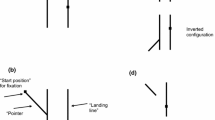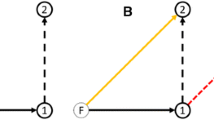Abstract
This experiment investigated the relative extent to which different signals from the visuo-oculomotor system are used to improve accuracy of arm movements. Different visuo-oculomotor conditions were used to produce various retinal and extraretinal signals leading to a similar target amplitude: (a) fixating a central target while pointing to a peripheral visual target, (b) tracking a target through smooth pursuit movement and then pointing to the target when its excursion ceased, and (c) pointing to a target reached previously by a saccadic eye movement. The experiment was performed with a deafferented subject and control subjects. For the deafferented patient, the absence of proprioception prevented any comparison between internal representations of target and limb (through proprioception) positions during the arm movement. The deafferented patient's endpoint therefore provided a good estimate of the accuracy of the target coordinates used by the arm motor system. The deafferented subject showed relatively good accuracy by producing a saccade prior to the pointing, but large overshooting in the fixation condition and undershooting in the pursuit condition. The results suggest that the deafferented subject does use oculomotor signals to program arm movement and that signals associated with fast movements of the eyes are better for pointing accuracy than slow ramp movements. The inaccuracy of the deafferented subject when no eye movement is allowed (the condition in which the controls were the most accurate) suggests that, in this condition, a proprioceptive map is involved in which both the target and the arm are represented.
Similar content being viewed by others
References
Arbib MA (1990) Programs, schemas, and neural networks for control of hand movements: beyond the RS framework. In: Jeannerod M (eds) Motor representation and control. (Attention and performance XIII). Erlbaum, Hillsdale, pp 111–138
Bard C, Fleury M, Teasdale N, Paillard J, Nougier V (1995) Contribution of proprioception for calibrating and updating the motor space. Can J Physiol Pharmacol 73:246–254
Blouin J, Bard C, Teasdale N, Paillard J, Fleury M, Forget R, Lamarre Y (1993) Reference systems for coding spatial information in normal subjects and a deafferented patient. Exp Brain Res 93:324–332
Blouin J, Teasdale N, Bard C, Fleury M (1995a) Arm movement control when target position is altered during saccadic suppression. J Mot Behav 27:114–122
Blouin J, Bridgeman B, Teasdale N, Bard C, Fleury M (1995b) Visual stability with goal-directed eye and arm movements toward a target displaced during saccadic suppression. Psychol Res 58:169–176
Bock O (1993) Localization of objects in the peripheral visual field. Behav Brain Res 56:77–84
Cole JD (1995) Pride and a daily marathon. MIT Press, Boston
Cole JD, Katifi HA (1991) Evoked potentials in a man with a complete large myelinated fibre sensory neuropathy below the neck. Electroencephalogr Clin Neurol 80:103–107
Delreux V, Vanden Abeele S, Crommelinck M, Roucoux A (1991) Interactions between goal-directed eye and arm movements: arguments for an interdependent motor control. J Mot Behav 23:147–151
Gauthier GM, Mussa Ivaldi F (1988) Oculo-manual tracking of visual targets in monkey: role of the arm afferent information in the control of arm and eye movements. Exp Brain Res 73:138–154
Gauthier GM, Vercher JL, Blouin J (1995) Egocentric visual target position and velocity coding: role of ocular muscle proprioception. Ann Biomed Eng 23:423–435
Honda H (1990) The extraretinal signal from the pursuit-eyemovement system: its role in the perceptual and the egocentric localization systems. Percept Psychophys 48:509–515
Jeannerod M (1991) A neurophysiological model for the direction of reaching movement. In: Paillard J (ed) Brain and space. Oxford University Press, Oxford, pp 49–69
Marteniuk RG (1978) The role of eye and head positions in slow movement execution. In: Stelmach GE (ed) Information processing in motor learning and control. Academic, New York, pp 267–288
Paillard J (1987) Motor versus sensorimotor encoding of spatial information. In: Ellen P, Thinus-Blanc C (ed) Cognitive processes and spatial orientation in animal and man. Nijhoff, Dordrecht, pp 1–34
Prablanc C, Echallier JF, Komilis E, Jeannerod M (1979) Optimal response of eye and hand motor systems in pointing at a visual target. I. Spatio-temporal characteristics of eye and hand movements and their relationships when varying the amount of visual information. Biol Cybern 35:113–124
Robinson DA (1965) The mechanics of human smooth pursuit movement. J Physiol (Lond) 180:569–591
Robinson DA (1973) Models of the saccadic eye movement control system. Kybernetik 14:71–83
Rothwell JC, Traub MM, Day BL, Obeso JA, Thomas PK, Marsen CD (1982) Manual motor performance in a deafferented man. Brain 105:515–542
Sainburg RL, Poizner H, Ghez C (1993) Loss of proprioception produces deficits in interjoint coordination. J Neurophysiol 70:2136–2147
Author information
Authors and Affiliations
Rights and permissions
About this article
Cite this article
Blouin, J., Gauthier, G.M., Vercher, JL. et al. The relative contribution of retinal and extraretinal signals in determining the accuracy of reaching movements in normal subjects and a deafferented patient. Exp Brain Res 109, 148–153 (1996). https://doi.org/10.1007/BF00228636
Received:
Accepted:
Issue Date:
DOI: https://doi.org/10.1007/BF00228636




